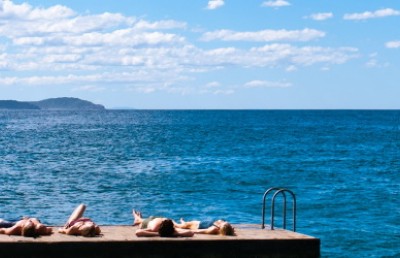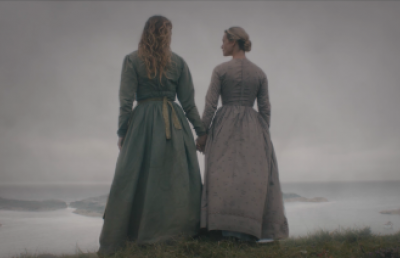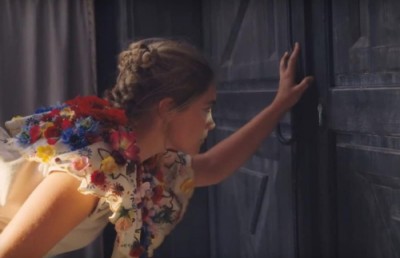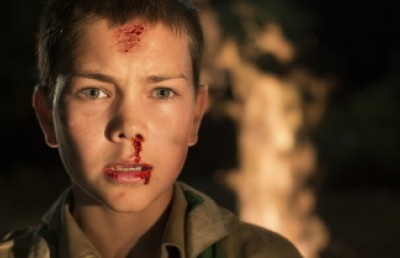The Bamboo Raft: The Near Impossibility of Making a Short Film
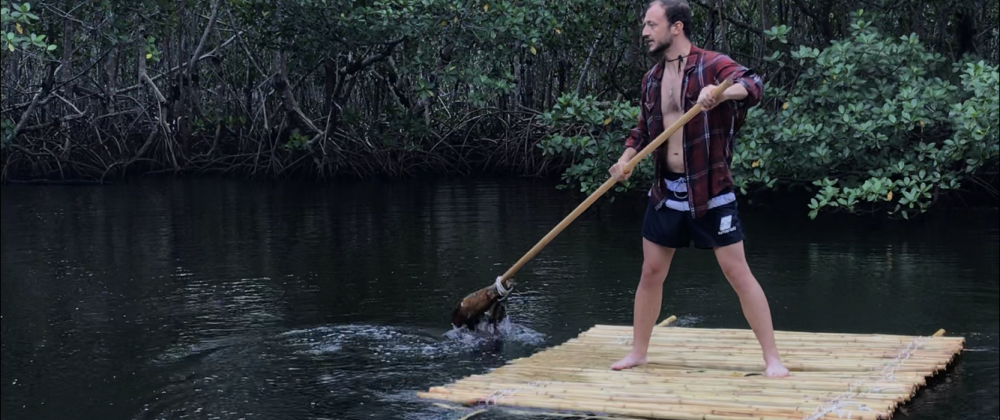
Bamboo rattles sounding a tap-tap of tiki drums— dew rolls off the canes as they clatter on the lawn. Up drifts a scent like cedarwood or tan, dead grass. Each pole is like a bone, smooth, yellow and segmented by bulging rings like vertebrae.
The sun is setting— red sky makes spiky black shadows out of the palm trees. This work has taken me all day. The neighbors have come and gone; the woman with her dog and the man with his cigarette, the kid with his skateboard have all asked: what am I doing?
2_480_640_90.jpg)
Tom Zompakos with bamboo raft leaning against his van
Dropping rope from red fingers, rasped raw with each new knot, I answer: I’m building a raft.
Somebody funny asks, “Shipwrecked at your apartment?”
And it is strange, the rattling pile of bamboo poles, the nested spools of rope scattered among them. Atop the pile sits the straw hat I don’t need anymore. There’s the red flannel shirt I’ve left in the dirt. Why a bamboo raft?
I daydreamed about it that morning— I’m building it tonight. That’s more or less all there is to it, I tell anyone who asks. The answer makes them smile.
Though in truth, like every raft, mine serves one purpose: escape.
Escape what?
That question is more difficult to answer. The raft is a way of getting a hold of something, of making it mine, of feeling I’m living, and creating not just existing. I’m an Eagle Scout. Getting outdoors and exploring somewhere new has always done alot for me. I’m also a playwright. This raft, I’ve decided, will be the subject of my first short film.
When you’re in the Boy Scouts, and you mention you want to write movies someday, somebody always mentions that Steven Spielberg is an Eagle. That’s true, and it’s pretty cool. He had a strange start with a short film that led to a mega-star’s career. I however, am going into this project with my expectations set firmly at zero.
It’s dark now. There’s a whole ten feet of square frame I must cover with a bamboo floor, with one, single inch-wide piece at a time. Ten feet an inch at a time- with fresh rope burn every inch. This will be a long night. With hands doing the repetitive work of lashing and weaving, my mind wanders to everything that could go wrong with this project. The list is long, but here are a few items to start it off. I don’t have a script. I don’t have a cast. I have one mostly-built raft and the glimmer of an idea, one that could either catch fire or go out forever.
But for now, it’s 3 a.m. and I’m going to stow this raft away and get a few hours of sleep. Sunday brings church. Monday brings work. As if to tease me while I work, the weather is perfect. The punishing summer heat is gone. November in Florida is dreamy, easy and ideal for idling outside all day. If it stays like this for the weekend, I’ll be set.
I look out the window, and daydream about syrupy Florida rivers shaded by green palms, swinging jungle vines, and the smooth bamboo canes of the raft floating under my feet. I need to drive an hour and half to get to the perfect river for filming. I’ve got to get the raft there, and now this thing is eight feet by ten feet, I’m not sure if my strap-it-to-the-roof-of-the-van plan will work. It’s much larger than the roof of my vehicle at this point.
And it’s not just logistics problems, I don’t have a script! All I’ve got is a raft. Doesn’t matter. It’s Wednesday, so there’s still time to write one. You know what? I should give myself a little more pressure by promising a cast there will be a great script for them. I start texting a few real-life hippies I made friends with at a music festival. I ask them if they want to sit around a bonfire and drink in a movie. I haven’t figured out where that piece will fit into the story, but I’m pretty sure it will be in there. They drink around bonfires in real life, so it’s not much of a stretch. A couple say yes, and that should be all I need. I tell them my camera guy will be there for sure (another white lie: he is on the fence, but I want him to feel a little extra pressure, too) and the whole thing will be a big old lark. They love the idea. I promise to send them the script soon. The script which still, of course, does not exist.
Where am I going from here? I’ve got a raft and a bonfire. I’ve got some hippies and me. That’s just not enough for a story. It’s not enough for a film. I’ve got to stitch it all up with a beginning, middle and end. I take up a white legal pad and a pen. I spin the pen. I pace. I make a peppermint and ginseng tea, let it cool and drink it. Cup’s now empty and so’s the page. I decide to write the script tomorrow.
Tomorrow passes, and now it’s Friday afternoon. I’m knee deep in one of those sleepy, never-ending 3pms, begging the clock to move faster with my eyes. No inspiration has come for the script, and I’ve told a whole bunch of people to show up tomorrow. I’m sick at the position I’ve put myself in, but I did it to myself. There’s nothing more to it than that.
Then bad news hits: the hippies have to cancel on me because they forgot they had a birthday party to attend. There goes my cast, the day before the shoot. My cameraman and director, Juan, is keeping me in suspense, too. This thing’s never going to happen, is it? I’ve been involved in four plays, and one other short film and the truth is it’s a miracle anything gets accomplished. Expensive equipment breaks, people leave batteries an hour and forty-five minutes away at home. Actresses and actors get into fights with their boyfriends. If you’ve got some perfect version of your artwork in your head, you’re only ever going to see thirty-five percent of whatever you had in mind. I didn’t even put money, time, permits, promotion, lack of audience, lack of interest or anything else on this list. In fact, if you sit down and do a real cost benefit analysis, there’s a strong case to be made for not even trying. Still, if you’ve got to do it, you do it.
2_630_473_90.jpg)
Left: Director Juan Pendas with screenwriter Tom Zompakos
I grind my teeth wondering how I’m going to pull this thing together out of the disappointment, sunk costs and nothingness into which it’s fast fading.
And oh yeah, I still haven’t written a script. I’ll get to that, but first I’ll need to make a run to Walmart for extra rope and ratchet straps.
I’ve got to drive two hours with the raft on top of my van. Dark daydreams plague me— bamboo poles whipping out of the lashings and flying off the top of my Kia. Red and blue police lights. The whole raft lifting up in the mighty wind and crashing into the windshield of the car behind me. Bamboo poles rolling all over the road. Manslaughter charges, time in jail, fines that crush me like a car compactor. Yes, I’d better lock this raft down as snug as I can if I’m going to pull this thing off.
I get back home and make a mug of tea. We’re still missing the script. I shut my phone off, and put my laptop away, and pull out pen and paper, and the time must be right because this time the script flows down, and I’m happy with it, or mostly happy. I send it to Juan.
The bamboo raft is leaning in the outdoor alcove of my apartment that leads to my washer and dryer. I’ve got to haul this thing across the grass to my parked car. It’s the middle of the night, so I take the closest parking spot: the handicapped one.
I tilt the raft onto my back again. It’s creaky and now dripping with the scattered rainfall that has fallen on and off all night long. Water soaks into my t-shirt, pools down the small of my back and in the band of my boxers. Steadily, I stutter-step my way to my van. I am now between the raft and the back of my van as I lean the bamboo against the back window. Then I squeeze out and walk around behind the raft. I grip it by the bottom bamboo pole and heave it up on top. Then out comes rope. I open all my windows and doors and tie the raft down through the roof of the car. I keep all knots as sailor-strong and scout-clean as I can. Now it’s time for a test.
I hop into my car and drive a couple of streets out, really whipping the van around the empty streets until I’m sure the raft is secure.
_440_330_90.jpg)
Michael Sassano and director Juan Pendas on site
I wake up to heavy rain smattering the windows and dark grey sky. Palm trees are bending back and their large green leaves are fanning and pinwheeling. It is not homemade raft weather, but I believe that plans that get canceled never happen, so I grab my pack, push the door open— feel that cool and strong wind with a mist of water on my cheek.
That grey sky is running into a dark gradient in the exact direction I plan to drive. I’ve got an hour and a half with that bamboo raft on top of my car, secured by an early morning improvised lash. I got a speeding ticket last week. In short, my nerves are on fire and as I hop in the car and roll out, my eyeballs keep darting to the mirror to check the edges of the raft, and the few inches of whipping rope end I can see from the driver’s seat.
Out on to I-95 South, I drive the exact speed limit: 65 miles per hour because any faster than that, and the whole raft starts pan-piping overhead, howling and tik-toking like forest imps playing giant wooden flutes and rattling drums.
Blue lights explode in the grey rain behind me. I’m being pulled over! It’s all finished. This short film will never get made. There’s no cast waiting for me there, my camera guy may or may not flake, and now I’m getting an expensive ticket. But then the Florida state trooper whizzes past me. Thank God.
A tailgater appears behind me. The other lanes are empty. Maybe she’s trying to teach me a little lesson, so she’s not just passing. I throw on the hazards until she pulls around me. I repeat this caution, this vigilance all the way down to Chapman Field park where I can launch my raft into a sluggish brown river that runs into a big saltwater lake, and ultimately out to the ocean. The bad weather is a blessing in the sense that it’s pretty likely I’ll have the water to myself. I ignore banner after banner of friend canceling on meeting me here. I’ve been trying to find a replacement for the cast that bailed.
At last, there’s Exit 70. Then four turns in the town and suddenly I’m on a dirt road. BLAM! That was a giant tough-to-see pothole. The dirt road is Swiss-cheesed with them, so I zig-zag around them at about 15mph.
Now, at long last, I pull into the parking lot of the boat launch. It’s marked by a giant Stonehenge style stone gate with ‘CANOE LAUNCH’ carved into the spotty grey granite. I leap out feeling clammy and relieved all over. The rain gets bad and comes down heavily.
Nothing to do but revise the script. A simple story- no dialogue. It all hangs on whatever footage we get here today, today when all my actors could swear I canceled for rain, and my cameraman isn’t answering his phone. Painful silence.
_630_354.PNG)
Actress Margarita Fernandez
If you set out on a mission to make a short film, you could wind up alone at a park in the rain with some weird and useless contraption on your car, about a hundred bucks in the hole. I wanted to kick a tree or something. How come other people get to make these things and I don’t? I’ve put so much work in on my own. So many hours of writing by myself. Now it’s all going to collapse at the last second.
Maybe I won’t get to do anything but a simple float downstream on this raft, all by myself. No cameras. No story. Just enjoy the moment. That wouldn’t be so bad. I mean, there’s only so much you can do on your own.
Now I have nothing to do but go through the short list of possible substitute cast members and other people who I know. I’ll call and text a few of them and see if they show up. Soon, I’ve left two voicemails and about six text messages. It seems like all I can do for now.
In that following moment of silence, visions of alligators and Florida’s invasive Nile crocodiles creep into my mind. Green reptile jaws and teeth like straight-edge knives snapping through my raft like a sushi mat, and snapping me up like a roll of sushi. I hope the Nile crocodile thing is an urban myth. Let’s look it up. No, it’s not a myth, we’ve really got them here in Florida. We’ve really got them.
Then my phone rings. Cameraman Juan confirms he will be there without a doubt, and it’s good, welcome news.
As for the cast, I’m down to texting a buddy of mine who works in a warehouse and a friend of a friend to play the other parts in the movie. No speaking, I promise them. This ain’t medical science, I tell them. If you show up, you’re qualified. The guy says OK, and the girl asks what she should wear. Flannel and shorts would be great, I tell her.
And just when it seemed things couldn’t get any bigger, lonelier, emptier or more futile, a boxy Scion pulls into the parking lot. Juan, the director and videographer, has found me. My face breaks into a grin. I’m not alone in this mission anymore, which is an enormous relief. He rolls into a parking space and hops out of the car. We dap up and then, for the first time in person, he sees the raft.
He curses. “This thing is gigantic!”
He’s starting to believe in this project. We take an end of the raft each, and walk it down to the canoe launch. Around a hooked dirt path with jungle plants on either side, there’s a ramp that leads down to one of those flexing, puzzle piece-style boat pads. There’s a groove in the middle for canoes.
_630_354.PNG)
Shooting the bonfire scene of The Bamboo Raft
Some craggy-faced park ranger wanders up, and gawks at the raft.
“Don’t think that’ll float,” he grunts. He crosses his arms to watch us, but then his radio buzzes and he steps away to answer it. “Park closes at sundown,” he says.
We set the edge of the raft in the water, and shove it off. The great board of side-by-side bamboo poles dips under the surface of the water, then it makes a bubbling ascension.
I’m dressed in blue trunks with white stripes, a red flannel shirt, a straw hat, and I’ve got an 8 foot pole for pushing off the bottom. Here goes nothing.
I step out onto the raft, and my weight carries out into the middle of the water. It’s a bit like standing on a surfboard, but with more room. I squat down and reach for the bottom of the river with my pole. The water’s depth is about 7 feet, but the bottom of the river is squishy, sludgy murk. There’s no point in trying to shove off of it. I stand back up and slowly spin-drift over the maple syrup-brown water with its flexing rolls and waves, its dimples and spray.
I’ve lost track of anything filming-related. I’m just navigating this thing and trusting Juan to do his thing from shore with our combined two iPhones and his stabilizer.
Water pools and rushes up between the bamboo poles and drains back down. The currents jam the raft into the wishbone-shaped roots of mangroves, mini-arcs of grey-barked rooty wood with beards of dirt— with black crabs crawling up the roots, fat, tank-built crabs. Curl your index and thumb into an ‘O’ shape to see the rough size of these crabs. Under the surface of the water, needle fish immobilize themselves near shaded shelter with a ripple motion running down their straight bodies. Their thin and pointy heads are still, their see-through fins undulate down their lengths, holding them in one mid-water place with gyroscopic power.
My bamboo raft snags in a mangrove. I’m being dragged through thin tendrils of tree vine, through thick spiderwebs woven in long-undisturbed places. I sit down, cross-legged on the raft to untangle myself, pawing at invisible spiderwebs.
Overhead, there are broad leaves the size of a person, and behind them the sky is grey. More herons take flight. Deep in the foliage, there is a rustling. My head snaps around and I see a raccoon of all things. Usually, they are only out at night, but there the robber-masked furball forages, blinking in the heavy shade, rummaging in thickets too tight-knit for a person to enter.
A hard jolt as the raft hits a rock— I shove my sounding rod off the rock and out more into the middle of the river. I reach the pole into the water to try shoving off the bottom once more. My arm plunges shoulder-deep into cold water. Can’t reach the bottom of the river anymore.
The current is strong, and now my pole won’t let me push off through the water anymore. All around the small mat of bamboo, green-brown water surges. Floating by the mangroves are two palm bark pieces the shape of duck fins. I catch the ribs of the mangroves with the end of my pole and drag the raft to the fin-shaped bark. I bring the bark aboard the raft, and whip a piece of string out of my pocket. I lash the fin-shaped bark to the end of the pole, and now I have a true oar.
Juan calls from shore. He says we should add the creation of the oar to the movie. It’s not in the script, but we both like it, so I agree to take the oar apart and do it again.
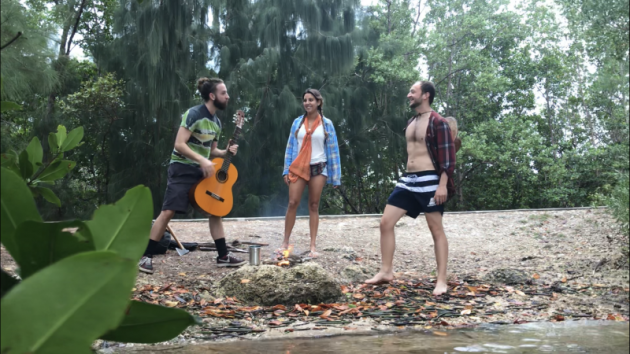
The full cast of The Bamboo Raft
Now the river is narrowing for a while. The jungle plants are getting closer. There are logs to push the raft between. There’s a larger body of water after this— a natural pool where the shape of the river, if seen from the top, fattens into a circular shape before feeding under a stone bridge.
Juan and I agree we probably have enough footage of the river journey. Now while we wait to see if the two cast members will show up, I grab the script and look at how we will re-order things to work in the new scenes. At first, we had the rafter meet four hippies. We only have one guy and girl planning on showing up for the bonfire scene. Now he’ll just be meeting two. That’s fine. That’s an easy change.
We walk to a riverbank with a nice stony field. We’ve got to set up a campfire. I make it happen with some quick starters and a blue Bic lighter. Now the cameras are nearly dead. Juan takes his shoes off to wade into the water for the perfect shot. He screams. He’s become tangled in old fishing wire with a rusty hook at the end of it. He thrashes with the cameras, and I watch from the shore, hands on my head, waiting for him to topple into the water and ruin his camera and mine at the same time.
Standing shivering and forgetting what scenes we still need, sun going down, and untrained actor and actress nervous about the camera, I think of all the hours poured into all the movie scripts in the world that never get made. The movies that get made and canned. The movies that lovingly crafted, then booed or ignored. The short films that nobody will ever see, and how this one, with its non-existent budget, its hangups, dying window of filmable light, and the reluctant cast might become one of them.
Juan steadies himself and soon we’re all back to work.
The actor and actress are now more or less panicking at the idea of being on camera. Juan is a large, reassuring presence, and he tells them it will all be OK, and all they need to do is behave normally and avoid looking at the camera. This advice seems to do the trick. However, it occurs to me that all the theater majors I knew, and there were so many, have vanished from my life at this critical moment. They’re scattered to the four winds, some with dreams alive, others with customer service jobs. The world belongs to the people who show up, as the saying goes.
The shoot wraps up and the sun sets. The girl has to leave, and I treat Juan and the actor to hibachi dinner. That makes up the entire second half of the movie’s budget. Hot sake is good after the draining day.
Weeks drag by, and it is becoming difficult to get Juan to upload his camera’s portion of the footage. Fear that something has happened, some sort of pocket deletion has erased all my work pester at me. Juan reassures me no such event has occurred.
My editor and I sit together with all of our raw footage. We use a notebook and paper to mock up a storyboard. I play him a song that will run underneath the entire footage. I explain how the scenes will change with the movements of the story. Then Juan said, “Tell you what. I see what it ought to be. Let me have it for a week, and give me a chance to blow you away.”
If someone you’re working with on a creative project says that, it’s time to get out of their way.
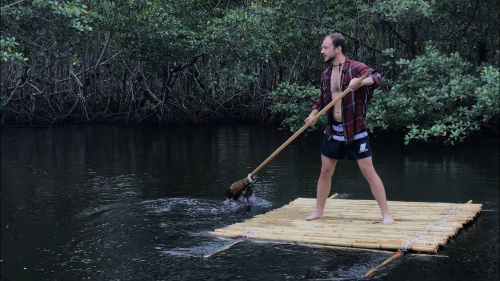
Tom Zompakos on the bamboo raft
He cut a take of it together, and in two weeks, we were at my place with a six-pack of beers between us projecting the film onto the wall. It was most of the way there, except for a little footage we would have to pull in from elsewhere. Well, then the holidays, all of Thanksgiving and all of Christmas interrupted us. Juan took a trip to Mexico and that interrupted us for another two weeks. A few people had asked me over and over again when the film was coming out and the only answer I could ever give was soon, soon. And in my head, after all these delays, I was worried the answer was never.
Then, after so many setbacks, after so many cancellations and delays, after so many false starts and gear hangups, finally, it was time to publish this short film. That’s exactly what we did. Over the next couple of weeks, about three hundred and eighty people saw it. I remember sitting with a buddy of mine while he had it up on his big screen one day. He watched the film and checked his phone often. In brief, I told him: you will never understand the full scope of everything that went wrong with this short film. The near impossibility of making this short film.
And you can view the finished film on youtube: https://youtu.be/VeGbQ56SX38



